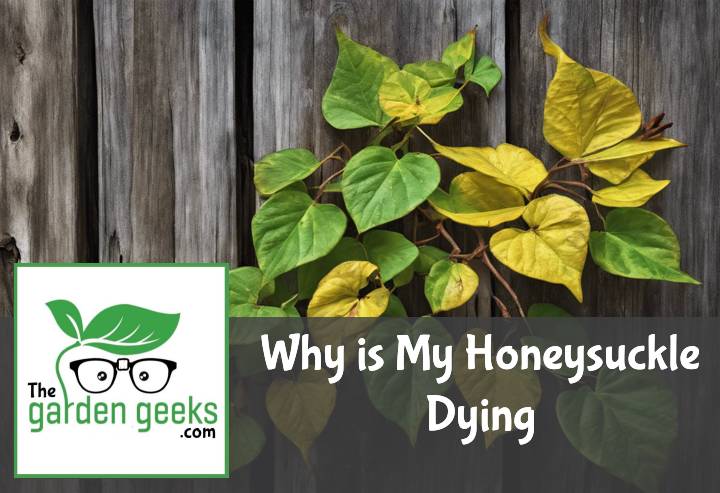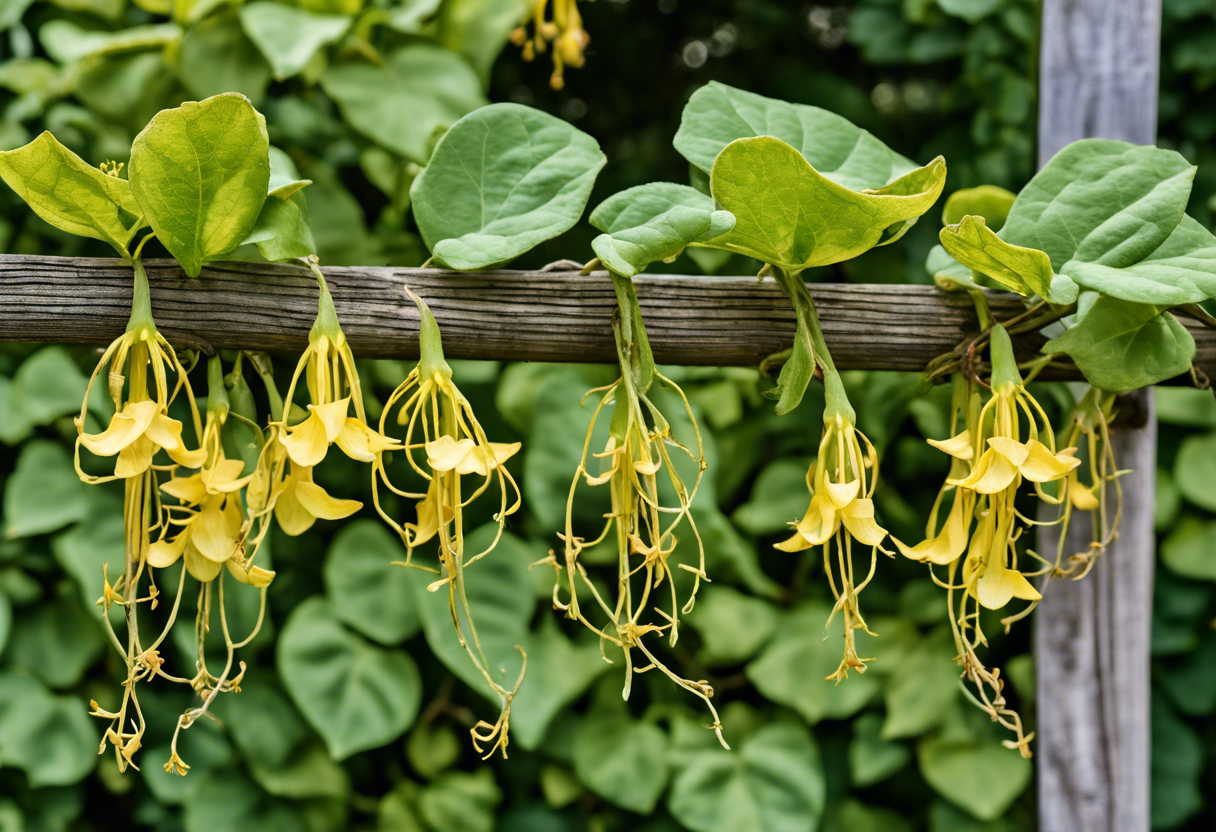Ever found yourself asking, “Why is My Honeysuckle Dying“? Trust me, I’ve been there too. One day you’re admiring your garden’s pride and joy, and the next it’s wilting faster than a vampire in sunlight!
Fear not fellow green thumbs. We’re about to get Sherlock Holmes on this mystery – looking for clues, identifying suspects, and hopefully saving our honeysuckle from an untimely demise. So grab your magnifying glass (or just your reading glasses) and let’s dive in!
Key Takeaways
- Honeysuckle plants may die due to improper watering, poor soil conditions, pests, or diseases.
- Overwatering or underwatering can cause root rot or dehydration respectively.
- Soil should be well-draining and rich in organic matter for optimal growth.
- Common pests include aphids and powdery mildew; use insecticidal soap or fungicides as treatment.
- Regular pruning helps prevent disease spread and promotes healthy growth.
- If plant is severely affected, consider replacing it with a disease-resistant variety.
Understanding Honeysuckle Plants
Alrighty then, let’s dive into the world of honeysuckle plants. These beauties have some specific growth requirements and plant characteristics that we need to get a handle on. We’ll chat about different honeysuckle varieties and how to give them the best care.
What is a Honeysuckle Plant?
So, what’s a honeysuckle? Well, it’s not just a sweet name for your sweetheart. It’s actually a type of plant known for its vibrant flowers and intoxicating scent.
Now, these plants come in all shapes and sizes. Some are bushy shrubs while others are climbing vines. And the varieties? Oh boy! From Japanese honeysuckles to trumpet honeysuckles, each one is unique in its own way.
The Ideal Conditions for Honeysuckle Growth
Let’s talk about the perfect conditions for these plants to thrive. First up is light. Honeysuckles love sunlight – they’re like little sunbathers soaking up those rays.
Next is soil type. They aren’t too picky but well-drained soil makes them happiest. Think of it as their favorite comfy couch.
Temperature-wise, honeysuckles can handle a range but they do prefer moderate climates. Too hot or too cold and they might throw a bit of a tantrum.
Lastly, watering needs – not too much, not too little, just right! Like Goldilocks’ porridge if you will. Overwatering can lead to root rot which is definitely not on our ‘why is my honeysuckle dying’ troubleshooting list!
Identifying Signs of a Dying Honeysuckle
If you’re asking yourself, “Why is My Honeysuckle Dying?”, then it’s time to play detective. The first step? Spotting the dying honeysuckle symptoms. Let’s dive in!
Discoloration and Wilting Leaves
Ever noticed your honeysuckle leaves turning a funky color? That’s honeysuckle leaf discoloration for ya! It could be yellowing or even brown spots popping up on those lovely leaves.
Now, if you see wilting, that’s another red flag. Wilting honeysuckle leaves are like a cry for help from your plant.
So what causes these issues? Could be lack of water, too much sun, or poor soil conditions. But don’t worry! A little TLC can turn things around.
Stunted Growth or Lack of Blooms
Another sign of an unhealthy honeysuckle is stunted growth. If your plant seems stuck in the kiddie pool while others are diving into the deep end, there might be a problem.
And let’s talk about blooms – or rather, the lack thereof. A honeysuckle not blooming is like a summer without ice cream – just wrong!
Reasons could range from inadequate sunlight to poor nutrition. But fear not! With some adjustments to its environment and diet, your honeysuckle can get back to blooming business.
Presence of Pests or Disease
Last but definitely not least – pests and disease. These uninvited guests can wreak havoc on your honeysuckles faster than ants at a picnic!
Common culprits include aphids and powdery mildew – nasty stuff that can lead to a seriously diseased honeysuckle.
But before you wave the white flag, remember: there are treatments available! From insecticidal soaps to fungicides, you’ve got options. So chin up, green thumb – your honeysuckle’s health is in your hands!
Common Reasons Why Your Honeysuckle Might Be Dying
So, you’re wondering “Why is My Honeysuckle Dying?” Well, there could be several reasons. It might be due to inadequate watering, poor soil conditions, extreme weather, or pests and diseases. Let’s dive in and figure out what’s going wrong with your honeysuckle plant care.
Inadequate Watering
Watering issues can put a serious damper on your honeysuckle’s health. Overwatering and underwatering both have their own set of problems.
Overwatering honeysuckle can lead to root rot, a nasty condition that can quickly kill your plant. On the other hand, underwatering honeysuckle leaves it parched and struggling for survival. Both scenarios show signs of water stress in plants.
The key is finding the sweet spot for watering needs of honeysuckles – not too much, not too little!
Poor Soil Conditions
Poor soil conditions are another common culprit when it comes to a dying honeysuckle plant. If your soil isn’t up to snuff, your plant will let you know through poor growth and yellow leaves.
Honeysuckles prefer well-draining soil rich in organic matter. If you’re seeing poor soil symptoms in plants like wilting or discolored leaves, consider improving soil for honeysuckles by adding compost or other organic material.
Extreme Weather Conditions
Extreme weather conditions can also take a toll on your honeysuckle. Frost can freeze its roots while excessive heat can cause heat stress in plants.
Protecting plants from frost damage involves covering them with frost cloths or moving potted plants indoors during cold snaps. As for heat stress, ensure your plant gets plenty of water during hot spells but remember not to overdo it!
Remember: weather impact on honeysuckles can be significant so keep an eye on those forecasts!
Pest Infestation and Diseases
Last but not least, pests and diseases can wreak havoc on your honeysuckle. Common honeysuckle pests include aphids and powdery mildew, both of which can cause significant damage if left unchecked.
Honeysuckle diseases like leaf blight or wilt can also lead to a dying plant. If you notice signs of pest infestation in plants such as chewed leaves or a sticky residue, it’s time to take action!
How to Diagnose the Problem with Your Honeysuckle
Diagnosing honeysuckle plant issues is like playing detective. You gotta look for clues, gather evidence, and solve the mystery of ‘Why is My Honeysuckle Dying‘. It involves inspecting your plant, testing the soil, and checking for any pesky pests or diseases.
Conducting a Thorough Inspection
First things first, put on your detective hat and start inspecting your honeysuckle. Look at those leaves! Are they yellow or brown? That’s a sign of an unhealthy honeysuckle. Now check out the stems. Are they brittle or soft? If yes, Houston we have a problem!
Next step in our thorough plant inspection, examine the flowers. They should be vibrant and full of life. If they’re wilting or discolored, it’s time to sound the alarm bells.
Testing the Soil Quality
Now let’s get down and dirty with some soil testing! The health of your honeysuckle heavily depends on its environment. So grab a soil test kit from your local garden store and check that pH level.
Honeysuckles love slightly acidic to neutral soil. If your soil is too alkaline or too acidic, it could be causing your honeysuckle distress. Remember folks, balance is key!
Also check for essential nutrients like nitrogen, phosphorus and potassium. These are the building blocks for healthy plants so if they’re lacking in these nutrients, you’ve found another clue in solving our mystery.
Checking for Signs of Pests or Disease
Last but not least, let’s talk about pests and diseases – every gardener’s nightmare! A dying honeysuckle could be under attack from bugs or falling victim to some nasty disease.
Look out for signs like holes in leaves or black spots on stems – these are telltale signs of honeysuckles pests and diseases. Common culprits include aphids, powdery mildew, or even honeysuckle leaf blight.
So there you have it folks! A step-by-step guide to diagnosing your honeysuckle problems. Remember, the first step in saving your plant is figuring out what’s wrong in the first place. So get out there and start investigating!
Solutions to Revive Your Dying Honeysuckle
If you’re asking, “Why is My Honeysuckle Dying?”, don’t fret. We’ve got some nifty tricks up our sleeve to revive your dying honeysuckle. Let’s dive in!
Adjusting Watering Techniques
First things first, let’s talk about honeysuckle watering techniques. Too much love (read: water) can drown your plant, while too little leaves it parched. It’s a delicate balancing act.
The trick is to keep the soil moist but not soggy. Overwatering and underwatering honeysuckles are both no-nos. So, remember folks, moderation is key here!
Improving Soil Quality
Next up on our honeysuckle revival solutions, we have soil quality. The right soil can make all the difference for your honeysuckles’ health.
Poor soil can stunt growth and lead to a sickly plant. But fear not! You can improve the soil for honeysuckles by adding compost or organic matter.
This enriches the soil, providing essential nutrients for healthier honeysuckles. Trust us; your plant will thank you!
Protecting Against Harsh Weather Conditions
Extreme weather conditions are like kryptonite for plants, including honeysuckles. Whether it’s scorching heat or freezing cold, both can cause significant damage.
So how do we protect honeysuckles from harsh weather? Simple! Provide shade during hot summers and cover during frosty winters.
Remember, a little care goes a long way in safeguarding your honeysuckles from extreme weather conditions.
Treating Pest Infestations and Diseases
Last but certainly not least in our quest to save wilting honeysuckle, we tackle pests and diseases head-on.
Common culprits include aphids and powdery mildew. But don’t worry, we’ve got you covered! Regular inspections and prompt treatment can keep these nuisances at bay.
So there you have it, folks! With these honeysuckle care tips, your plant will be back to its blooming best in no time.
Preventive Measures to Keep Your Honeysuckle Healthy
You might be wondering, “Why is my honeysuckle dying?” Well, let’s shift gears and talk about honeysuckle care. We’re going to dive into preventive measures that can help maintain your healthy honeysuckle.
Regular Pruning and Maintenance
First off, let’s chat about honeysuckle pruning. It’s like a haircut for your plant! Regular snips can help maintain the health of your honeysuckle.
Pruning isn’t just about aesthetics though. It helps in maintaining healthy honeysuckles by preventing overcrowding and promoting better air circulation. So, don’t forget to prune your honeysuckle regularly!
Proper Watering and Fertilizing
Next up on our list of lifesavers is proper watering and fertilizing. Just like us, plants need hydration too!
Watering your honeysuckles correctly plays a crucial role in their health. Too much or too little water can lead to problems. And let’s not forget about food – fertilizers are the main course for these green beauties.
The right amount of fertilizer can boost the growth of your honeysuckles significantly. Remember, it’s all about balance when it comes to watering and fertilizing honeysuckles properly.
Pest and Disease Prevention
Last but definitely not least, we have pest and disease prevention. No one likes uninvited guests, especially when they’re harmful pests or diseases!
Preventing pests in honeysuckles is crucial for their wellbeing. Regular checks can help you spot any unwanted visitors early on.
Similarly, disease prevention for honeysuckles involves keeping an eye out for signs of trouble like yellow leaves or wilting stems. Early detection means early action! So keep those peepers peeled for anything unusual with your plant.
To Wrap Up
Like a toddler with a new toy, your honeysuckle needs attention to thrive. Remember, proper watering, sunlight, and pest management are key. If you’re still asking “Why is My Honeysuckle Dying“, don’t worry! Head over to this forum for more advice.
In the end, it’s all about giving your plant some TLC. So roll up those sleeves and let’s save that honeysuckle!





